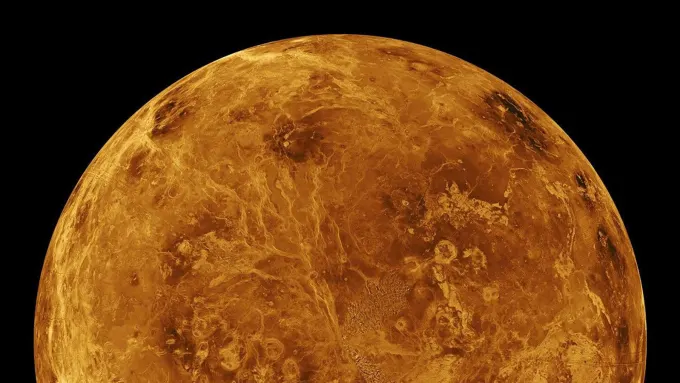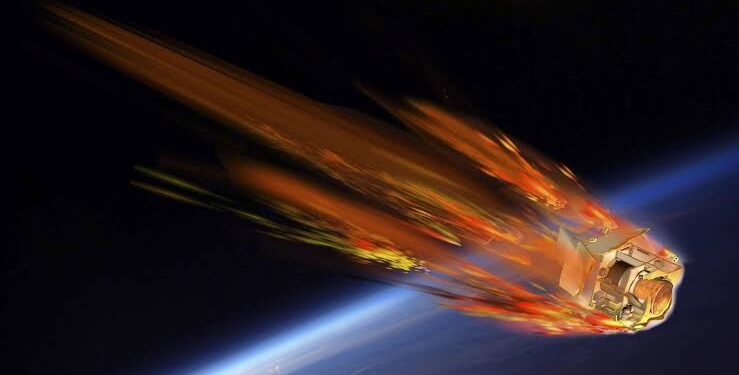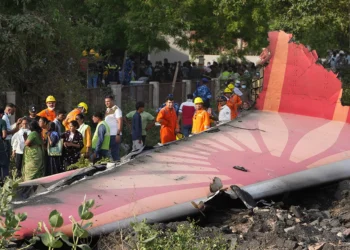A failed Soviet-era spacecraft intended to explore Venus is on a collision course with Earth. Launched in March 1972, the capsule failed to reach its transfer orbit and is now hurtling back towards our planet.

The object, known as Kosmos482, has been tracked by space agencies and astronomers as it makes its final descent. The reentry is expected to be a significant event, highlighting the issue of cold war space debris still orbiting Earth.
As the world watches, the reentry of this Soviet spacecraft serves as a reminder of the historical space exploration efforts and the challenges associated with space debris.
Key Takeaways
- The Kosmos482 spacecraft is expected to reenter Earth’s atmosphere.
- Launched in 1972, it was intended to explore Venus but failed to reach orbit.
- The reentry highlights the issue of space debris from the Cold War era.
- Space agencies and astronomers are tracking the capsule’s final descent.
- The event underscores the challenges of dealing with historical space debris.
The Imminent Return of Kosmos482
After decades in orbit, Kosmos482 is finally reentering Earth’s atmosphere. This event has sparked widespread interest due to the spacecraft’s historical significance and the unpredictability of its landing site.


Current Status and Predicted Timeline
The cylinder-shaped craft, approximately 1 meter in diameter, is predicted to crash back to Earth overnight. Experts are closely monitoring its descent, providing updates on its expected reentry time and potential impact zone.
Some key points to consider:
- The current orbit and predicted reentry timeline
- The role of international space surveillance in tracking Kosmos482
- The potential risks associated with its reentry
Why This Space Debris Is Making Headlines
Kosmos482 is making headlines not just because of its impending crash but also due to its historical significance. Launched during the Cold War era, it represents a piece of space exploration history.
- Historical value as a Soviet-era spacecraft
- Unpredictable reentry path, captivating global attention
- Potential to provide insights into space debris reentry
As the world watches, experts are working tirelessly to track Kosmos482’s reentry, providing live updates and insights into this significant event.
Soviet Spacecraft Kosmos482: The Venus Mission That Never Was
Kosmos482, a spacecraft intended to probe Venus, encapsulates the challenges and aspirations of the Soviet space program in the early 1970s. As part of the Soviet Union’s Venus exploration program, Kosmos482 was designed to gather crucial data about Venus, a planet shrouded in mystery due to its dense atmosphere.
Original Mission Objectives
The primary objective of Kosmos482 was to land on Venus and transmit data about the planet’s surface and atmosphere. The mission was part of the Venera program, a series of spacecraft sent to Venus by the Soviet Union. The Venera missions were groundbreaking, aiming to understand the extreme environment of Venus, including its surface temperature, atmospheric composition, and pressure.
The mission objectives of Kosmos482 were aligned with the broader goals of the Venera program, focusing on understanding the Venusian environment. This included studying the planet’s atmosphere, surface conditions, and potential geological features.
Technical Specifications of the Venus Lander
The Kosmos482 spacecraft included a Venus lander designed to withstand the extreme conditions on Venus. The technical specifications of the lander were critical to its mission.
Descent Module Design
The descent module of Kosmos482 was engineered to survive the harsh conditions during its descent into Venus’ atmosphere, including high temperatures and crushing pressures. The module was designed to slow down using a combination of aerodynamic braking and a parachute system, ensuring a controlled descent.
Scientific Instruments Onboard
The lander was equipped with a suite of scientific instruments designed to study Venus’ atmosphere and surface. These included temperature sensors, atmospheric composition analyzers, and cameras. The data collected by these instruments would have provided valuable insights into Venus’ environment.

| Instrument | Purpose |
|---|---|
| Temperature Sensors | Measure surface and atmospheric temperatures |
| Atmospheric Composition Analyzers | Analyze the chemical composition of Venus’ atmosphere |
| Camera | Capture images of Venus’ surface |
The 1972 Launch and Subsequent Failure
In March 1972, the Soviet Union launched Kosmos482, a spacecraft designed to visit Venus, but it failed to escape Earth’s orbit. This mission was part of the Soviet Venus exploration program, aimed at understanding the planet’s atmosphere and surface conditions.
The Launch from Baikonur Cosmodrome
The Kosmos482 spacecraft was launched from the Baikonur Cosmodrome in Kazakhstan, a key site for Soviet space missions during the Cold War era. The launch was conducted using a Molniya-M rocket, a variant of the R-7 rocket family that was widely used for Soviet space missions. Initially, the launch seemed successful, but the spacecraft failed to achieve the necessary velocity to escape Earth’s orbit and proceed to Venus.
What Went Wrong: The Orbital Breakup
The failure of Kosmos482 to escape Earth’s orbit resulted from an orbital injection malfunction. After the launch, the spacecraft broke apart into several pieces, with some components reentering the Earth’s atmosphere shortly after. Interestingly, four titanium spheres from the spacecraft were reported to have landed in a farmer’s field near Ashburton, New Zealand, just a few days after the launch. This incident highlighted the unpredictability of space debris reentry and the potential risks associated with it.
50 Years in Orbit: How Kosmos482 Survived This Long
The Kosmos482 Soviet Venus probe’s prolonged existence in space is a remarkable phenomenon. Astronomers and space traffic experts have closely monitored the object as its orbital path gradually descends to lower altitudes.
Orbital Mechanics and Decay
The orbital decay of Kosmos482 is influenced by various factors, including atmospheric drag and gravitational forces. As the spacecraft’s orbit decays, it encounters increasing atmospheric resistance, which slows it down and causes its orbit to shrink further.
| Factor | Influence on Orbital Decay | Description |
|---|---|---|
| Atmospheric Drag | Slows down the spacecraft | Causes the orbit to decay due to friction |
| Gravitational Forces | Affects the spacecraft’s trajectory | Influences the orbital path due to gravitational pull |
The decay process is complex and involves intricate interactions between the spacecraft and the Earth’s atmosphere. Atmospheric drag plays a crucial role in this process, as it gradually reduces the spacecraft’s velocity, causing its orbit to decay.
Materials and Construction That Withstood Time
The longevity of Kosmos482 can be attributed to its robust construction and the materials used in its manufacture. The Soviet spacecraft was built to withstand the harsh conditions of space, including extreme temperatures and radiation.
“The construction of Kosmos482 reflects the advanced engineering capabilities of the Soviet space program during the Cold War era.”
The use of durable materials and a well-designed structure enabled Kosmos482 to survive for an extended period.

Tracking Kosmos482: How Experts Monitor Its Final Descent
The Aerospace Corporation is at the forefront of tracking Kosmos482, utilizing cutting-edge technology to monitor its reentry. This involves a multi-faceted approach to predict the spacecraft’s final descent accurately.
Aerospace Corporation’s Tracking Methods
The Aerospace Corporation employs a range of techniques to track Kosmos482. Two primary methods are radar technology and predictive modeling techniques.
Radar Technology Used
Radar technology plays a crucial role in tracking Kosmos482. By using radar, experts can determine the spacecraft’s current position, velocity, and trajectory. This information is vital for predicting its reentry path. Advanced radar systems can provide detailed data on the spacecraft’s orbital parameters.
Predictive Modeling Techniques
In addition to radar, predictive modeling techniques are used to forecast Kosmos482’s reentry. These models take into account various factors, including atmospheric conditions, gravitational influences, and the spacecraft’s physical characteristics. By analyzing these factors, experts can estimate the likely reentry window and potential impact zone.
International Space Surveillance Network Involvement
The international space surveillance network is also involved in tracking Kosmos482. This network comprises various organizations and countries working together to monitor space debris and predict reentries. By sharing data and resources, the network enhances the accuracy of reentry predictions.
“The global collaboration in space surveillance is crucial for predicting the reentry of objects like Kosmos482,” said an expert in the field.
The network’s involvement ensures that the tracking data is comprehensive and reliable.
Through the combined efforts of the Aerospace Corporation and the international space surveillance network, experts are well-equipped to monitor Kosmos482’s final descent. Their work provides critical insights into the reentry process, helping to mitigate potential risks and inform the public.
Live Updates: Following Kosmos482 Reentry in Real-Time
As Kosmos482 hurtles towards Earth, enthusiasts and scientists alike are eagerly awaiting its reentry. The anticipation is building up, and various resources are available to track this event in real-time.
Official Tracking Resources
For accurate and up-to-date information, one can rely on official tracking resources. The Aerospace Corporation and other space surveillance entities provide regular updates on Kosmos482’s trajectory. These organizations utilize advanced radar and satellite data to predict the reentry path.
Some of the official resources include:
- United Nations Office for Outer Space Affairs: Provides updates on space debris and reentries.
- Aerospace Corporation: Offers detailed tracking information and analysis.
- NASA’s Orbital Debris Program Office: Publishes reports on significant reentries.
Social Media and Citizen Science Contributions
Social media platforms and citizen science initiatives play a significant role in tracking Kosmos482’s reentry. Enthusiasts and amateur astronomers contribute valuable observations that can help refine predictions.
Some ways to participate include:
- Following space-related hashtags on Twitter and other platforms.
- Participating in online forums like Reddit’s r/space.
- Contributing observations to citizen science projects.
As the reentry event unfolds, these collective efforts will provide a comprehensive understanding of Kosmos482’s final descent.

Predicted Impact Zones: Where Might Kosmos482 Land?
With Kosmos482’s reentry imminent, the focus is on predicting the potential impact zones across the globe. The spacecraft’s final descent is being closely monitored by experts who are working to determine the likely landing sites.
Calculating the Reentry Path
The reentry path of Kosmos482 is calculated using complex algorithms that take into account various factors such as the spacecraft’s velocity, altitude, and atmospheric conditions. Aerospace experts utilize advanced tracking methods to predict the trajectory of the spacecraft.
Potential Landing Sites and Probabilities
According to NASA, the landing location could be “anywhere between 52°N and 52°S latitude,” a vast area that encompasses Africa, parts of North America, and South America. The probability of the spacecraft landing in a specific region is determined by various factors, including the reentry path and the density of the atmosphere.
Safety Concerns: Is Kosmos482 Dangerous?
The impending reentry of Kosmos482 has prompted discussions about the dangers posed by surviving space debris. As this Soviet-era Venus probe hurtles towards Earth, concerns about its potential impact are growing among experts and the public alike.
Surviving Components and Their Potential Hazards
Experts warn that Kosmos482 was designed to withstand the harsh conditions of Venus’ atmosphere, suggesting it could potentially survive reentry into Earth’s atmosphere. “This object was designed to survive reentering Venus, so there’s fair odds that it’ll survive coming back (to Earth) in one piece,” said Marlon Sorge, a space debris expert. The components most likely to survive include:
- Metallic parts of the spacecraft structure
- Certain electronic components
- Parts of the propulsion system
Official Safety Recommendations
While the chances of Kosmos482 causing significant damage are considered low, officials are still urging caution. The Aerospace Corporation and other space surveillance agencies are closely monitoring the situation, providing updates on the probe’s trajectory. As the reentry event approaches, the public is advised to follow official guidance and stay informed through reliable sources.

The Cold War Context: Soviet Venus Exploration Program
The Cold War fueled a competitive spirit in space exploration, with the Soviet Union launching a series of Venera missions to explore Venus. This program was part of a broader effort to understand our nearest planetary neighbor and to demonstrate technological prowess during a period of geopolitical tension.
The Space Race Beyond the Moon
The space race between the Soviet Union and the United States was not limited to the Moon; it extended to other planets in the solar system, with Venus being a prime target due to its proximity to Earth and its mysterious surface hidden beneath thick clouds. The Soviet Union’s Venera program was a series of missions designed to study Venus’s atmosphere and surface.
Venera Missions and Their Scientific Legacy
The Venera missions were a landmark in space exploration, with several spacecraft successfully landing on Venus and returning data about its surface conditions. These missions provided the first close-up images of Venus’s surface and critical data on its temperature, pressure, and composition.
Venus Surface Conditions Discovered
The Venera missions revealed a hostile environment on Venus, with surface temperatures reaching as high as 462°C (863°F) and crushing pressures. These extreme conditions posed significant challenges to the design and operation of the spacecraft.
Impact on Planetary Science
The data returned by the Venera missions significantly advanced our understanding of Venus and its place in the solar system. The findings have implications for the study of planetary formation and evolution, as well as for the search for life beyond Earth.
Scientific Interest in the Reentry: What Experts Hope to Learn
The impending reentry of the Kosmos482 spacecraft offers a unique opportunity for researchers to study material degradation and atmospheric reentry physics. This event is particularly significant because it involves a spacecraft that has been in orbit for over 50 years, providing a rare chance to observe the effects of long-term exposure to space on its materials and structure.
Material Degradation in Space
Material degradation in space is a critical area of study, as it directly impacts the design and longevity of spacecraft. Over time, materials exposed to space can undergo significant changes due to factors such as radiation, extreme temperatures, and micrometeoroid impacts. By examining Kosmos482 during its reentry, scientists hope to gain insights into how its materials have degraded, which can inform the development of more durable spacecraft in the future.
Atmospheric Reentry Physics
The reentry of Kosmos482 also provides an opportunity to study atmospheric reentry physics. As the spacecraft encounters the Earth’s atmosphere, it will experience intense heat and friction, causing its surface to ablate and potentially break apart. By monitoring this process, researchers can refine their understanding of reentry dynamics, which is crucial for predicting the fate of other space debris and for designing spacecraft that can safely reenter the atmosphere.
Similar Space Debris Reentries: Historical Precedents
Historical space debris reentries offer valuable insights into the risks and consequences associated with space exploration. The reentry of space debris is not a new phenomenon; it has been occurring since the dawn of space exploration. Understanding these historical precedents can provide context and lessons for current and future space missions.
Skylab and Other Notable Reentries
One of the most notable examples of space debris reentry is Skylab, America’s first space station, which reentered Earth’s atmosphere in 1979. Skylab’s reentry was a significant event, scattering debris across Western Australia. Other notable reentries include the Upper Atmosphere Research Satellite (UARS) and ROSAT, a German X-ray telescope, both of which made headlines due to their uncontrolled reentries.
Lessons Learned from Previous Space Debris Events
The reentry of these space debris objects has taught the space community valuable lessons. For instance, the reentry of UARS highlighted the challenges in predicting the exact location of reentry, while ROSAT’s reentry underscored the potential risks associated with surviving debris. These events have driven home the importance of designing satellites and space stations with disposal in mind at the end of their mission, to minimize risk upon reentry.
Key takeaways from these historical events include the need for better tracking and prediction capabilities, as well as the development of guidelines and regulations for responsible space operations. By studying these precedents, we can improve our handling of future space debris reentries.
Conclusion: The Final Chapter of a Cold War Space Relic
The reentry of Kosmos482 marks the end of an era for a piece of Cold War space history. As this Soviet Venus probe meets its fiery demise, it serves as a reminder of the vast amount of space debris orbiting our planet. “What goes up must come down,” said Parker Wishik, a spokesperson for The Aerospace Corporation, highlighting the inevitable fate of objects launched into space.
The kosmos482 conclusion brings to a close a chapter on the challenges faced by space-faring nations during the Cold War era. As a cold war space relic, Kosmos482’s final chapter is not just about the technical aspects of its reentry but also about the historical significance it holds. The reentry of such debris raises important questions about space sustainability and the need for responsible space exploration practices.
As we bid farewell to Kosmos482, we are reminded of the importance of tracking and monitoring space debris to ensure safe and secure space operations. The final chapter of Kosmos482 serves as a catalyst for discussions on the future of space exploration and the management of space debris.
FAQ
What is Kosmos482?
Kosmos482 is a Soviet-era spacecraft that was intended to explore Venus but failed to escape Earth’s orbit and is now expected to reenter the atmosphere.
When was Kosmos482 launched?
Kosmos482 was launched in 1972 from Baikonur Cosmodrome.
Why is Kosmos482 making headlines now?
Kosmos482 is making headlines because it is expected to reenter Earth’s atmosphere, sparking public interest in its historical significance and potential impact.
What were the original mission objectives of Kosmos482?
The original mission objectives of Kosmos482 were to explore Venus as part of the Soviet Venus exploration program.
How is Kosmos482 being tracked?
Kosmos482 is being tracked by experts using methods employed by the Aerospace Corporation and the international space surveillance network.
Can I follow Kosmos482’s reentry in real-time?
Yes, you can follow Kosmos482’s reentry in real-time through official tracking resources, social media, and citizen science initiatives.
Where is Kosmos482 expected to land?
The predicted impact zones for Kosmos482 are being calculated by experts, with potential landing sites and probabilities being assessed.
Is Kosmos482 a safety concern?
There are safety concerns related to Kosmos482’s reentry, as surviving components could potentially pose hazards, and official safety recommendations are being issued.
What can we learn from Kosmos482’s reentry?
Experts hope to learn about material degradation in space and the physics of atmospheric reentry from Kosmos482’s reentry.
Are there historical precedents for space debris reentries like Kosmos482?
Yes, there have been other notable space debris reentries, such as Skylab, and lessons have been learned from these experiences.
What is the significance of Kosmos482’s reentry?
Kosmos482’s reentry is significant both as a piece of space history and as a reminder of the issues surrounding space debris.
How did Kosmos482 survive for over 50 years in orbit?
Kosmos482 survived for over 50 years in orbit due to a combination of its orbital mechanics, materials, and construction.
What was the Soviet Venus exploration program?
The Soviet Venus exploration program, which included the Venera missions, was a series of space missions aimed at exploring Venus during the Cold War era.





















































